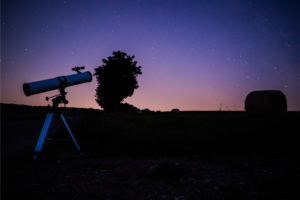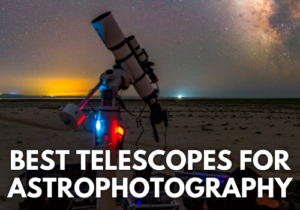Best Telescope For Land Viewing & Terrestrial Use 2024; Reviews
Disclosure: This post contains affiliate links and I may earn a small commission (at no extra cost to you) if you click through and make a purchase. Thanks in advance – I really appreciate it!
Here in this “Best Telescope For Land Viewing & Terrestrial Use” article we’ve rounded up 11 of the top telescopes of various types, specifications, and budget perfectly suited for long distance viewing of land, sea, wildlife, birds, scenery, ocean, people and more. Below, you’ll find in-depth reviews of each, as well as an elaborate buying guide to help you pick out the one that suits you the most.
COMPARISON TABLE
| Image | Title | Best For | Features | Price | Buy |
|---|---|---|---|---|---|
Top Top
Top
Top Top
Top
Top | Orion 9024 AstroView | Best Overall | Type:Refractor, Aperture: 90mm (3.54″), Focal length: 910mm, Focal Ratio: f/10.1 | See on Amazon | |
 Top
Top
Top
Top | Celestron - AstroMaster 80AZS | Best For Land & Sea | Type: Refractor, Aperture: 80 mm / 3.1", Focal length: 400mm, Focal Ratio: f/5 | See on Amazon | |
 Top
Top
Top
Top | Explore One CF400SP | Best For Wildlife | Type: Refractor, Aperture: 70 mm / 2.75", Focal length: 400mm, Focal Ratio: f/5.7 | Buy on Amazon | |
 Top
Top
Top
Top | OYS Telescope | Best For Terrestrial Use | Type: Refractor, Aperture: 80 mm/3.14", Focal length: 500 mm | See on Amazon | |
 Top
Top
Top
Top | Celestron - 70mm Travel Scope | Best Telescope To See 10 Miles | Type: Reflector, Aperture: 70mm (2.8″), Focal length: 400mm, Focal Ratio: f/5.7 | See on Amazon | |
 Top
Top
Top
Top | Orion 9823 Apex 102mm Maksutov-Cassegrain Telescope | Best For Long Distance Viewing | Type: Maksutov-Cassegrain, Aperture: 102mm (4″), Focal length: 1300mm, Focal Ratio: f/12.7 | See on Amazon | |
 Top
Top
Top
Top | Gskyer Telescope 600x90mm | Best Refractor | Aperture:90mm(3.5”), Focal length: 600mm, Focal Ratio: f/6.7 | See on Amazon | |
 Top
Top
Top
Top | Meade Instruments – Infinity 80mm | Best Telescope For Beach House | Type: Refractor, Aperture: 80mm (3.15″), Focal length: 400mm, Focal Ratio: f/5 | See on Amazon | |
 Top
Top
Top
Top | Celestron - PowerSeeker 50AZ | Best For Kids | Type: Refractor, Aperture: 50 mm / 2", Focal length: 600mm, Focal Ratio: f/12 | See on Amazon | |
 Top
Top
Top
Top | ECOOPRO Telescope | Best for Family | Type: Refractor, Aperture: 70 mm / 2.75", Focal length: 360mm, Focal Ratio: f/12 | See on Amazon | |
 Top
Top
Top
Top | Sarblue Maksutov-Cassegrain Telescope | Best For Ocean Viewing | Type: Maksutov-Cassegrain Aperture: 60mm(2.36″) Focal length: 750mm | See on Amazon |
Product prices and availability are accurate as of the date/time indicated and are subject to change. Any price and availability information displayed on [relevant Amazon Site(s), as applicable] at the time of purchase will apply to the purchase of this product.
Prices pulled from the Amazon Product Advertising API on:Are you a keen observer of boats, rivers, architecture or simply just want to see your surroundings up close? Land Telescopes are essentially refractor telescopes. Refractor telescopes are most suited for land viewing or terrestrial use because they are designed with lenses rather than mirrors that invert images the other way.
Hence, daytime viewing using a refractor telescope require the use of an image erector diagonal in order to correctly invert the viewed images. This special type of device will fit in between the eyepiece and telescope. It typically contains a series of mirrors or prisms, configured and coordinated to “flip” an image into the correct orientation.
This article offers a list of telescopes that are good for both celestial as well as terrestrial use and they either come with an image erector or do not need one.
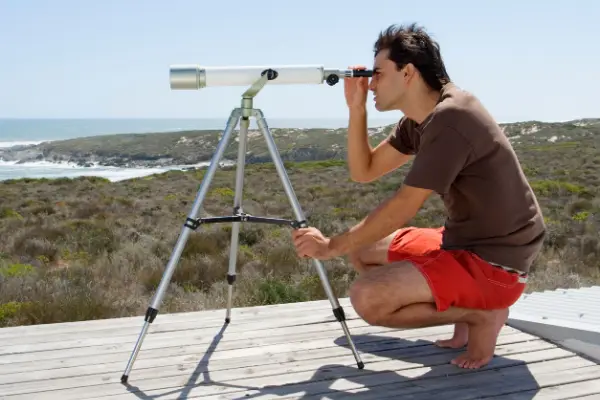
Best Terrestrial Telescope For Land Viewing 2021
With so many models with so many features available today, it can be a tedious task to find the best terrestrial telescope. We have analyzed the main features ( aperture, focal length, image erector diagonal, portability, affordability etc.) that make a good land viewing telescope that you can use to enjoy the daytime viewing.
Best Overall
Orion 9024 AstroView
- Type: Refractor
- Aperture: 90mm (3.54″)
- Focal length: 910mm
- Focal Ratio: f/10.1
- Mount: Equatorial
- Eyepiece: 20 mm, 4 mm
- Magnification: 36x, 91x
- Weight: 23.7 lbs.(10.75 kg)
- Our Rating: 9.2/10
Prices pulled from the Amazon Product Advertising API on:
Product prices and availability are accurate as of the date/time indicated and are subject to change. Any price and availability information displayed on [relevant Amazon Site(s), as applicable] at the time of purchase will apply to the purchase of this product.
The Orion AstroView has exceptionally good optics. Its excellent optics, weight and size make it one of the best telescopes under 300 with a 90mm aperture and 910mm focal length.
This good looking telescope would be a great choice if you are interested in long distance viewing across land or the ocean. The telescope will also look great in a beach house or an apartment balcony.
Moreover, views of the planets and Moon through the f/10 AstroView 90 telescope are nothing short of spectacular. When aimed at the Moon, the AstroView 90 yields tack-sharp views of the rocky lunar surface with craters and mountainous regions visible in crisp, high-contrast detail.
On a clear evening, you can expect to see Jupiter’s cloud banding and all four of its major Galilean moons.
Depending on the time of year, the Orion AstroView 90mm EQ Refractor can also provide your whole family with exquisite views of Saturn and its stunning rings, also its largest largest moon known as Titan.
The two eyepieces included are a 25mm and a 10mm one which offer a magnification power of 36x and 91x respectively. The eyepieces are of good quality and the package also contains a 90º mirror star diagonal which means you will see the images with the correct side up.
Following a simple alignment procedure, you can use a 6×30 finder scope to accurately aim the AstroView 90mm refractor at objects in the sky like the Moon, bright planets, nebulae and star clusters.
The AstroView 90mm Equatorial Refractor comes with the Orion EQ-2 equatorial mount, which allows for easy manual tracking of celestial objects as they appear to move across the night sky.
All you have to do is occasionally adjust the equatorial mount’s R.A. (Right Ascension) slow-motion cable to keep any object centered in the telescope eyepiece.
The included aluminum tripod is lightweight and features adjustable legs and a tripod accessory tray for a hassle-free viewing session.
The entire AstroView 90 telescope, fully assembled, weighs only 24 pounds, and being a refractor it doesn’t need collimation, so you can pick it up and easily move it around in one piece or keep it fully assembled and ready to use at a moment’s notice.
Pros:
- Great optics
- Spectacular views of the moon and planets
- Quality components
- Equatorial mount that makes it easy to track object as they transit on the night sky
Cons:
- Slight wobble at focus
Best For Land & Sea
Celestron – AstroMaster 80AZS
- Type: Refractor
- Aperture: 80 mm / 3.1
- Focal length: 400 mm
- Focal Ratio: f/5
- Mount: Alt-Azimuth
- Eyepiece: 20mm, 10mm
- Weight: 10.4 lb (4.7 kg)
- Our Rating: 9.2/10
Prices pulled from the Amazon Product Advertising API on:
Product prices and availability are accurate as of the date/time indicated and are subject to change. Any price and availability information displayed on [relevant Amazon Site(s), as applicable] at the time of purchase will apply to the purchase of this product.
The Celestron astromaster 80AZS refractor telescope is a user-friendly and powerful refractor telescope. It has fully-coated glass optics, two eyepieces, a strong and lightweight frame, an adjustable tripod, a star pointer, and a red dot finderscope.
With a short 400 mm focal length (f/5), the Celestron AstroMaster 80AZS refractor is perfect for viewing star clusters and nebulae. At the same time, this versatile instrument can also be transformed into the ideal daytime spotting scope for land viewing using the included erect image star diagonal. As a result, this short refractor is well-suited for celestial as well as terrestrial observing.
Setting up the telescope is a breeze and will have you observing in no time. Even on your first time out, you can assemble the telescope and its accessories in just a few minutes.
The adjustable tripod legs allow you to customize the telescope’s height or place it on raised surfaces like a picnic table.

The AstroMaster 80AZS comes with two eyepieces (20mm and 10mm), erect image diagonal, and finderscope. The two eyepieces offer different magnifications to view your intended object.
The erect image diagonal allows for right-side-up viewing ideal for terrestrial subjects but can also be used for celestial objects. The red dot finderscope will help you quickly center an object in your eyepiece for easier observing.
An included accessory tray will help you keep track of eyepieces and other small items while observing.
Pros:
- Powerful refractor
- Great for land viewing
- 80mm optics
- Quick setup
- Lightweight frame
- Plenty of accessories
Cons:
- The mount is mostly plastic
Related
Best For Wildlife
Explore One CF400SP
- Type: Refractor
- Aperture: 70 mm / 2.75
- Focal length: 400 mm
- Focal Ratio: f/5.7
- Mount: Alt-Azimuth
- Eyepiece: 20mm, 6mm
- Magnification: 20x, 67x
- Weight: 10.4 lb (4.7 kg)
- Our Rating: 9/10
Prices pulled from the Amazon Product Advertising API on:
Product prices and availability are accurate as of the date/time indicated and are subject to change. Any price and availability information displayed on [relevant Amazon Site(s), as applicable] at the time of purchase will apply to the purchase of this product.
This easy-to-use achromatic refractor telescope is ideal for beginner and intermediate astronomers, stargazers and nature lovers.The Explore One CF400SP Telescope with its 70mm aperture and 400mm focal length, comes with two interchangeable eyepieces (20mm and 6mm) that will magnify objects by 20 or 67 times.
The telescope is Ideal for astronomical and terrestrial viewing, and it comes equipped with an easy-to-use manual alt-azimuth mount and adjustable-height tripod to enjoy views of the moon or constellations and meteor showers, or use it as a conventional telescope for terrestrial use for bird, boat, or nature-watching.
Its red-dot finder has an un-magnified view to make finding subjects fast and star-hopping navigation easier, with a simple aiming dot that won’t obstruct dim or small targets.
The telescope also comes with a Smartphone adapter so you can easily capture and share images and videos.
The Explore One CF400SP Telescope comes with instructions and an easy-to-understand online step-by-step video guide to help you set up, so that you can begin to have fun with your telescope.
Pros:
- Great optics for the price
- Can be used with iPhone or Android smartphone
- Easy to use and set up
- Great for kids as well as adults
Cons:
- Not for DSOs
Best For Terrestrial Use
OYS Telescope
- Type: Refractor
- Aperture: 80 mm / 3.14
- Focal length: 500 mm
- Mount: Alt-Azimuth
- Eyepiece: 20mm, 10mm
- Magnification: 25x, 50x
- Our Rating: 9/10
Prices pulled from the Amazon Product Advertising API on:
Product prices and availability are accurate as of the date/time indicated and are subject to change. Any price and availability information displayed on [relevant Amazon Site(s), as applicable] at the time of purchase will apply to the purchase of this product.
OYS 80500 telescope is one of the best telescope that is equally good for celestial as well as terrestrial use. This telescope comes with 2pcs interchangeable eyepieces (10mm, 20mm), which offers varying magnification from 25X-50X and increases the range of viewable objects.
High-quality multi-coated glass optics including a refractor-style 80mm objective lens with high transmittance is perfect for daytime birding, nature study, and scenic viewing, as well as nighttime stargazing and Moon-watching.
It is lightweight and portable, easy to set up and intuitive to use, gives sharp views, and requires practically no maintenance.
The telescope has high-quality multi-coated glass optics with high transmission that increases the brightness of celestial objects and provides clean, crisp images of wildlife, the moon, and planets, delivering 99% total light transmission while protecting your eyes.
The telescope also comes with a smartphone adapter with 1.25″ eyepiece featuring 1.5X Barlow lens that converts smartphones into professional digital eyepieces for the traditional optical instruments. It is quality, sturdy and super easy to use. Most importantly, it makes alignment of the camera and optics super fast.
The telescope is perfect for astronomy beginners to observe up-close celestial objects at night and terrestrial objects during the day.
Pros:
- Great for land viewing as well as the Moon
- Comes with phone adapter
- Easy to assemble & use
- Solid and sturdy mount
Cons:
- Pricey
Best Telescope To See 10 Miles
Celestron – 70mm Travel Scope
- Type: Reflector
- Aperture: 70mm (2.8″)
- Focal length: 400mm
- Focal Ratio: f/5.7
- Mount: Alt-az
- Eyepiece: 20mm, 10mm
- Magnification: 20x, 40x
- Weight: 4.2 lbs (1.9 kg)
- Our Rating: 9/10
Prices pulled from the Amazon Product Advertising API on:
Product prices and availability are accurate as of the date/time indicated and are subject to change. Any price and availability information displayed on [relevant Amazon Site(s), as applicable] at the time of purchase will apply to the purchase of this product.
This telescope works great considering the fact that it is an inexpensive, portable scope. It provides wide, clear views of the land, sky or the ocean that compare with much more expensive models.
The aperture performs surprisingly well given its size, and will most likely suit your needs given that it is a compact, portable and one of the best telescope for long distance land viewing.
The Travel Scope also comes pre-assembled and ready-to-use, so you can just grab it and go.
Its an easy to use and easy to set up telescope and you don’t have to exert a lot of effort on the installation of this travel scope. Moreover, you don’t even need any tools or equipment to assemble the scope before using it.
The 2.76 inch aperture is well-suited for the purpose of this home telescope and provides bright and crisp views given its size.
All of its optical components are glass coated for an efficient performance. Nevertheless, the light weight tripod is readily adjustable made from pre assembled aluminum and silver finish.
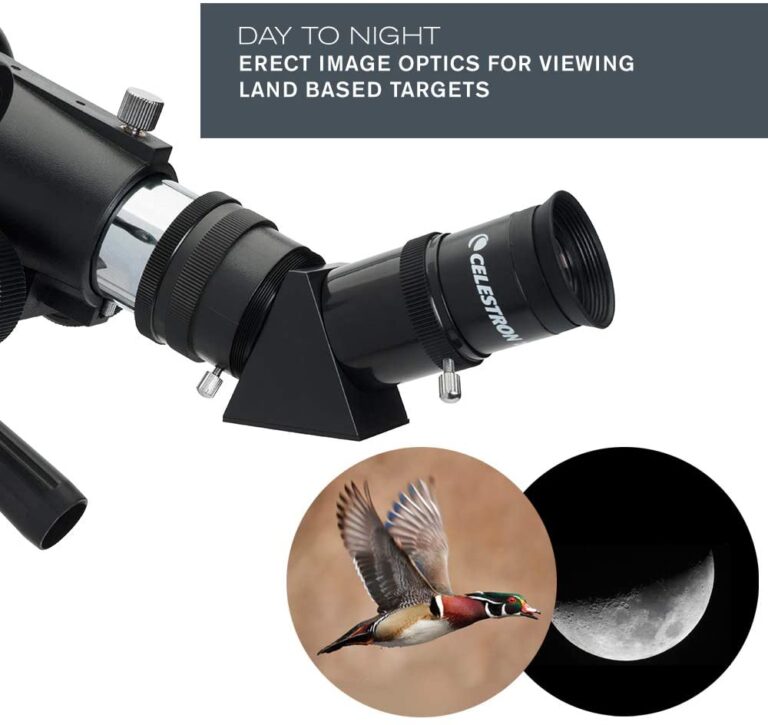
Incorporating a focal length of 400 mm, this device allows you to see clearly the rings of Saturn or the craters of the Moon. It should give you the magnification you need to spot the terrestrial objects you’re looking for in the night sky.
It is compactly built with the 70 mm refractor including two eyepieces used for high and low powered purposes. Nevertheless, the 20 mm eyepiece possesses 20x magnification while the 10 mm eyepiece has 40x magnification.
Also included is Sky X software, which allows you to learn the basics of astronomy and how to use your new telescope. Sky X is a great addition to any telescope and is an excellent tool to help beginners.
It features a smooth functioning altazimuth mount for easy location and shooting over several celestial bodies.
It is also suitable for astrophotography as it comes with a 2.5-degree field of view for greater scope and to enhance the picture quality that will be taken.
The Travel Scope is easy enough for any family member to use at home, it’s also a great telescope for more experienced astronomers will also be able to make great use of its features.
Pros:
- Easy to Use
- Perfect for home use
- Lightweight and highly portable
- Affordable Price
- Excellent optics
- Dual powered eyepieces
- Simple assembly
Cons:
- Shaky tripod
Best For Long Distance Land Viewing
Orion 9823 Apex 102mm
- Type: Maksutov-Cassegrain
- Aperture: 102mm (4″)
- Focal length: 1300mm
- Focal Ratio: f/12.7
- Mount: OTA
- Eyepiece: 25mm
- Magnification: 52x
- Weight: 5 lbs (2.26 kg)
- Our Rating: 9/10
Prices pulled from the Amazon Product Advertising API on:
Product prices and availability are accurate as of the date/time indicated and are subject to change. Any price and availability information displayed on [relevant Amazon Site(s), as applicable] at the time of purchase will apply to the purchase of this product.
The Orion Apex 102mm Maksutov-Cassegrain Telescope exhibits all the performance of classic long-tube 102mm refractors, and easily outperforms smaller refractors on views of the planets and Moon as well as on faint nebulae and star clusters.
Its long focal length allows high-power study of Jupiter’s cloud belts and Red Spot, and Saturn’s rings, and provides long reach for capturing distant terrestrial targets.
The Apex 127 focuses with the same moving-mirror system most catadioptrics use, and comes with a Maksutov-thread visual back, though you can buy an adapter to use Schmidt-Cassegrain threaded accessories.
The 1.25” visual back included has built-in T-threads to attach your DSLR camera. Attaching an SCT-thread adapter and a 2” SCT diagonal will result in some vignetting with wide-field eyepieces thanks to the scope’s narrow baffle tube and undersized primary mirror, but you can still use them to some extent.
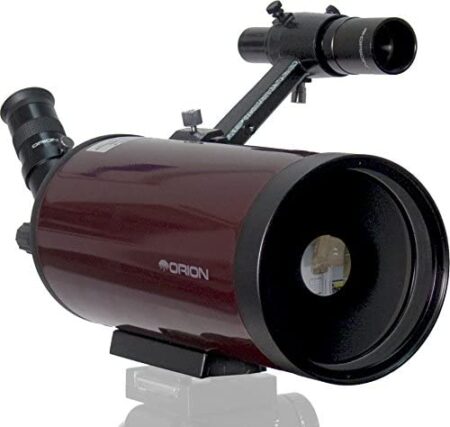
Like most telescope optical tubes, the Apex 102mm has a Vixen-style dovetail bar with ¼ 20 holes attached so you can either attach it to a Vixen-compatible mount or a heavy-duty photo tripod.
Speaking of accessories, the Apex 102mm comes with a multi-coated 25mm Sirius Plossl telescope eyepiece (1.25″) and a 45° diagonal that provides a correctly-oriented field of view. As does the correct-image finder scope (6×26 on Apex 102), which makes locating objects a cinch.
The StarMax 127 does do a pretty good job for terrestrial photography. With a 2x Barlow, a mount with motorized tracking, and a webcam-style CCD like the ZWO ASI120 or a Celestron NexImage series camera, you can get high-resolution images of the Moon, planets, wildlife, scenery or people.
Pros:
- Great optics
- Can also be used as a terrestrial telescope
- Extremely portable
- Versatile
- Comes with a carry bag
Cons:
- Requires a heavy duty mount
Best Refractor
Gskyer Telescope 90mm
- Type: Refractor
- Aperture: 90mm(3.5”)
- Focal length: 600mm
- Focal Ratio: f/6.7
- Mount: Altazimuth Mount
- Eyepiece: 25mm,10mm,5mm
- Magnification: 24x, 60x, 120x
- Weight: 18 lbs. / 8.2 kg
- Our Rating: 9.2/10
Prices pulled from the Amazon Product Advertising API on:
Product prices and availability are accurate as of the date/time indicated and are subject to change. Any price and availability information displayed on [relevant Amazon Site(s), as applicable] at the time of purchase will apply to the purchase of this product.
Gskyer is a German company and is one of the best telescope brands in the world, known to produce high-quality telescopes.
This is a great starter telescope for the explorer who intends to take their telescope with them on their journeys. Hiking, camping, and even moonlit fishing trips will be more fun when you have this telescope along with you.
The Gskyer AZ90600 is one of the best terrestrial telescopes. If you live in the city and you aren’t able to see much of the sky due to light pollution, you’ll want a telescope like this that’s easy to carry with you.
The 90 millimeter aperture is perfect for viewing most of the things you’d want to view, and all of the glass optics are coated to automatically adjust the brightness of the stars to a level safe and comfortable for observation.
Though this is a beginner telescope, you can use it to observe the moon, stars, people, wildlife, seas and more.
It also comes with a smartphone adapter, which allows you to use the phone as a screen, or as a camera to take great pictures.
Plus, this model is extremely easy to assemble and doesn’t require any calibration. If you’re a telescope beginner, you won’t have to worry about any tricky steps or complicated tests.
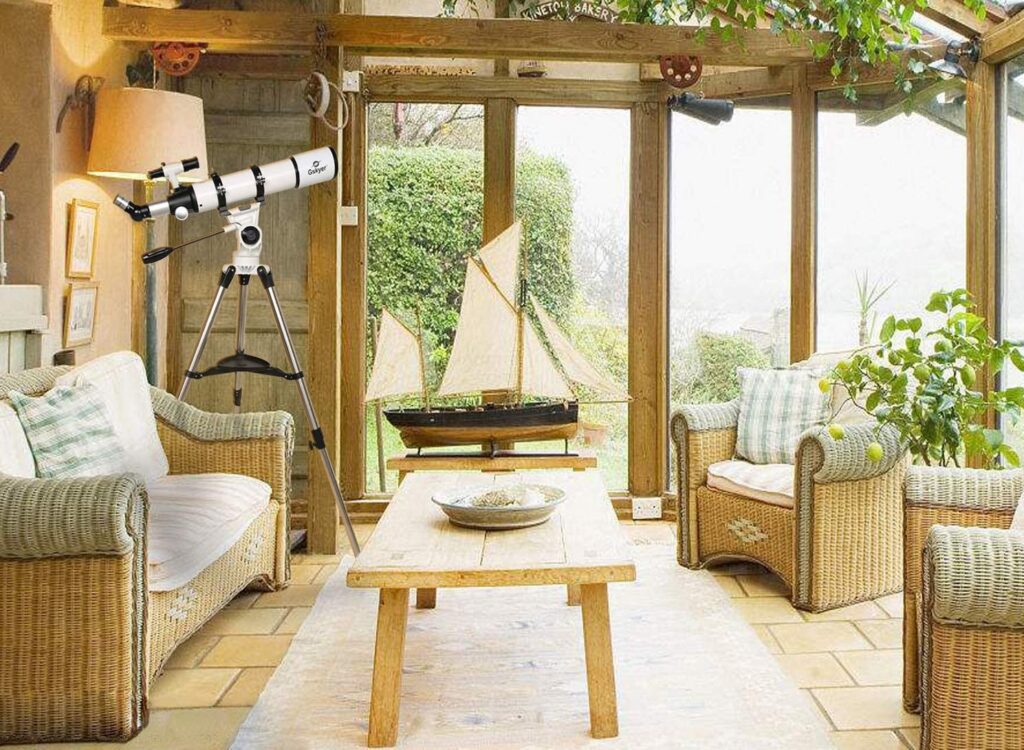
The Gskyer AZ90600 comes with an adjustable tripod. This adjustable aluminum tripod offers the viewer many different viewing positions. The height of the aluminum tripod can be adjusted from about 31.5-inch to 49-inch.
This is one of the best telescope for families and children, it’s 90mm (3.5″) aperture gives bright, sharp images for both land and celestial objects.
Whether you’re viewing the rings of Saturn, the moons of Jupiter, surface details on the Moon, or terrestrial objects, this one of the best telescope for land viewing will allow you to explore the land, mountains, ocean and beyond.
Pros:
- Large aperture
- 3 eyepieces
- Smartphone adapter
- Easy to assemble and use
- Adjustable tripod
- Perfect travel telescope
Cons:
- Good for viewing planets, stars not so much
Best Telescope For Beach House
Meade Instruments – Infinity 80mm
- Type: Refractor
- Aperture: 80mm (3.15″)
- Focal length: 400mm
- Focal Ratio: f/5
- Mount: Alt-Azimuth
- Eyepiece: 25mm, 9mm, 6.5mm
- Magnification: 48x
- Weight: 10.8 lbs. (4.9kg)
- Our Rating: 8.4/10
Prices pulled from the Amazon Product Advertising API on:
Product prices and availability are accurate as of the date/time indicated and are subject to change. Any price and availability information displayed on [relevant Amazon Site(s), as applicable] at the time of purchase will apply to the purchase of this product.
The Meade Instruments Infinity 80mm Altazimuth Refractor Telescope is a great telescope for budding astronomers and other enthusiasts just getting started in the world of astronomy. It accurately captures both terrestrial and celestial bodies in clear detail.
Many beginners and professionals alike have agreed that it is one of the best telescopes for teenagers.
The Meade Instruments Infinity 80mm Telescope comes as a complete set with a tripod, altazimuth mount, eyepieces and other accessories. You can use the telescope to view the moon, stars, planets, meteor showers and other celestial objects.
The Infinity telescope has a 80mm aperture and focal length of 400mm (f/5). The Alt-azimuth mount includes slow-motion control cables that allow for easy and quick viewing across different directions.
With the included accessories such as a Red-Dot Viewfinder, 2x Barlow Lens, and 3 Eyepieces that provide varying levels of magnification – this will give you versatility with short and long range distances, the Infinity 80mm comes complete with everything you need to view the planets, scenery, birds, wildlife or the seas.
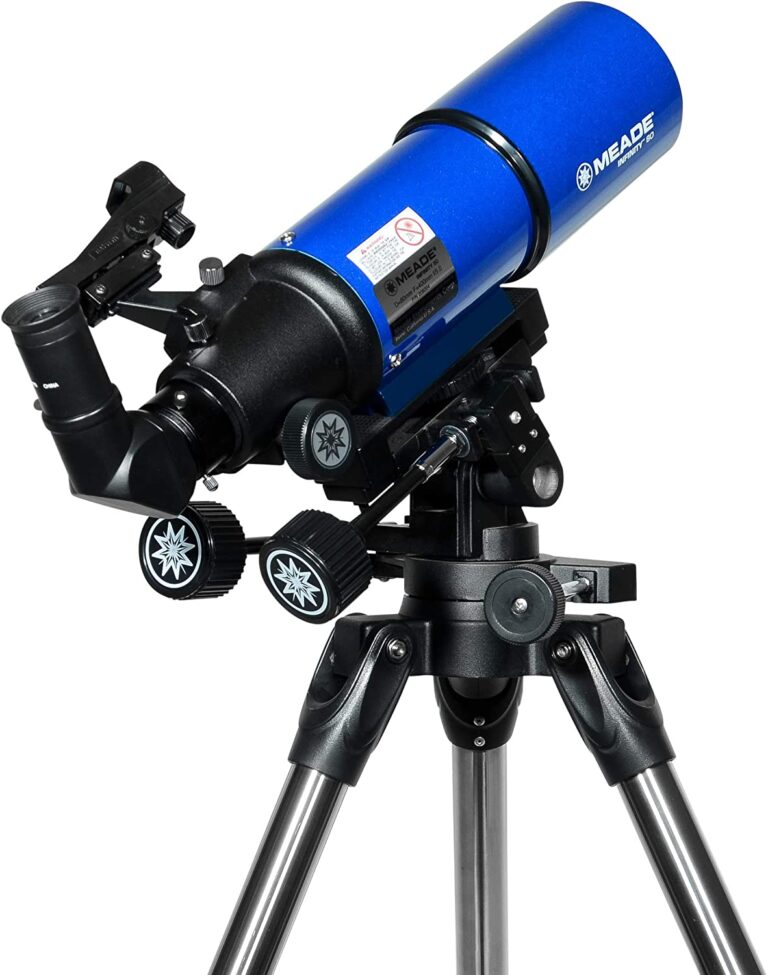
The Infinity 80 is again primarily a telescope for low magnifications and wide fields of view. With this scope you can see hundreds and hundreds of open star clusters making it one of the best telescope for teenagers.
It features a stainless steel tripod that you can adjust to meet your viewing needs. The durable SS tripod offers a stable platform when you are viewing the land or the ocean.
Also included in the shipped product package is an astronomy DVD containing more than 10,000 different celestial objects which the user can use to observe and identify major celestial objects.
The telescope Comes with 3 eyepieces that provide low, medium and high powered magnification for viewing a wide range of stars, planets and terrestrial objects.
Pros:
- Good for astrophotography
- Decent optics for a beginner telescope
- Comes with 3 eyepieces
- Includes a software for Windows integration
- Displays more than 10,000 celestial objects including planets, stars, galaxies
Cons:
- Setup time is a bit long
- Software is compatible only with Windows
Best For Kids
Celestron – PowerSeeker 50AZ
- Type: Refractor
- Aperture: 50 mm / 2
- Focal length: 600mm
- Focal Ratio: f/12
- Mount: Alt-Azimuth
- Eyepiece: 20mm, 12mm, 4mm
- 3x Barlow lens
- Magnification: 30x, 50x, 150x
- Weight: 5 lbs (2.26 kg)
- Our Rating: 8/10
Prices pulled from the Amazon Product Advertising API on:
Product prices and availability are accurate as of the date/time indicated and are subject to change. Any price and availability information displayed on [relevant Amazon Site(s), as applicable] at the time of purchase will apply to the purchase of this product.
The PowerSeeker 50 50mm f/12 AZ Refractor Telescope from Celestron is a starter scope designed to introduce viewers to astronomy by giving them a complete setup for viewing the moon, planets, and meteor showers.
Three eyepieces provide 30x, 50x, and 150x magnifications with a 3x Barlow lens that triples the magnification of each eyepiece for a wider range of observing possibilities.
This is not a professional telescope but perfectly suitable for a kid or adults who want to travel with it for scenery or land viewing.
The fully coated glass optical components deliver bright and clear images. The images are also correctly oriented (means the objects don’t look upside down) due to the correct images prism that’s included which makes the telescope ideal for both terrestrial and night sky viewing.
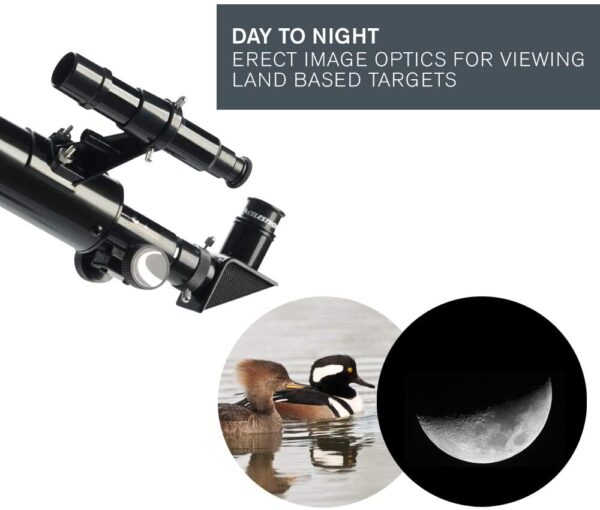
When it comes to celestial observation, you can view larger planets like Saturn and it’s ring, Jupiter and its Moons and craters on the Earth’s Moon.
As with most telescopes there is downloadable software included, and here we have the SkyX First Light Edition astronomy software which has 10,000 objects in it’s database, printable sky maps and 75 enhanced images.
The telescope has an easy setup which requires no tools. It only needs to be attached with the accompanying tripod and the eye pieces need to be inserted. After that, the telescope is ready for both terrestrial and celestial observations.
The telescope also comes with a convenient tray to house all the accessories.
Pros:
- Best for kids
- Good for larger planets
- Great for terrestrial use
Cons:
- Flimsy tripod
- Cheap eyepieces and Barlow lens
Best For Family
ECOOPRO Telescope
- Type: Refractor
- Aperture: 70 mm / 2.75
- Focal length: 360mm
- Focal Ratio: f/12
- Mount: Alt-Azimuth
- Eyepiece: 25mm, 10mm
- Magnification: 51x,128x
- Our Rating: 8/10
Prices pulled from the Amazon Product Advertising API on:
Product prices and availability are accurate as of the date/time indicated and are subject to change. Any price and availability information displayed on [relevant Amazon Site(s), as applicable] at the time of purchase will apply to the purchase of this product.
The Ecoopro Telescope is one of the best telescopes available for kids and adults. You can buy it for a kid who wants to learn more about space or give it as a gift to a professional astronomer. It has features that support the needs of everyone.
The 70mm refractor is excellent to observe faraway sky objects and vast landscapes. You do not have to go through the tiring assembly, as it is easy to assemble. The magnification is powerful that brings the faraway stars, galaxies, planets, and other objects close to you.
The telescope features all coated glass optical components, Lenses are composed of multi layered glass with a green coating that provides clean, crisp views, delivering 99% total light transmission.
The lightweight and compact structure allow you to take it on trips and other outdoor adventures. It has exceptional features at a very reasonable price.
This 70mm telescope excels at daytime land viewing, terrestrial use as well as viewing wildlife, scenery and casual nighttime observing of the Moon.
Pros:
- Lightweight
- Easy to set up
- Affordable
- Durable
- High magnification
- Highly portable
Cons:
Not for faint sky objects
Best Telescope For Ocean Viewing
SARBLUE Mak-Cass Telescope
- Type: Maksutov-Cassegrain
- Aperture: 60mm(2.36″)
- Focal length: 750mm
- Eyepieces: 20mm
- Magnification: 37.5x
- Weight: 2.62 lbs. (1.18 kg)
- Our Rating: 8/10
Prices pulled from the Amazon Product Advertising API on:
Product prices and availability are accurate as of the date/time indicated and are subject to change. Any price and availability information displayed on [relevant Amazon Site(s), as applicable] at the time of purchase will apply to the purchase of this product.
The Maksutov-Cassegrain offers superb optical performance. The design corrects the known optical problems such as coma (found in reflector telescopes) while also correcting chromatic aberration (found in refractors). The result is high-contrast detailed views of both terrestrial or celestial targets.
In a extremely compact tube, the mak60 offers great viewing capacity as a beginner telescope.
The telescope not only delivers vivid high-contrast images for daytime viewing such as birds and wildlife, but also enables astronomical exploration including Saturn, Jupiter, craters on the Moon, etc.
The SARBLUE Mak60 is one of the best maksutov cassegrain telescopes for kids and adults who are beginners in the field of astronomy.
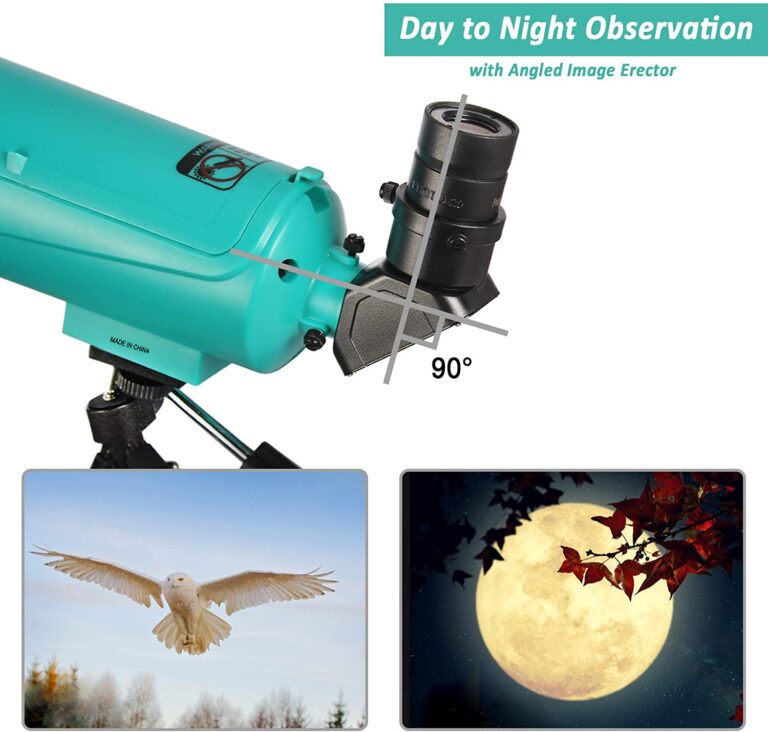
The telescope is designed in such a way that the detachable lid reveals the internal construction of the telescope and helps children and beginners understand the intrinsic working details of the telescopes, making it perfect for gifting it to a budding astronomer.
Moreover, with a long focal length of 750mm, the tube length is only 200mm, which makes it easy to store and carry it to your favorite viewing spot for great views of the night sky.
The telescope comes with a high-quality 20mm wide eyepiece which gives 37.5X magnification, providing high-power sharp views on distant objects.
It also comes with a phone adapter, a tabletop tripod and an erect-image diagonal. The included phone adapter and erect-image diagonal makes it one of the best mak-cass telescopes for terrestrial use or ocean viewing.
Pros:
- Perfect for children
- Lightweight, easy to carry
- Great for iphone/android astrophotography
- Good optics for the price
- Best value telescope
- Great spotting scope
Cons:
- Not for professionals
Telescope For Land Viewing & Terrestrial Use - Buying Guide
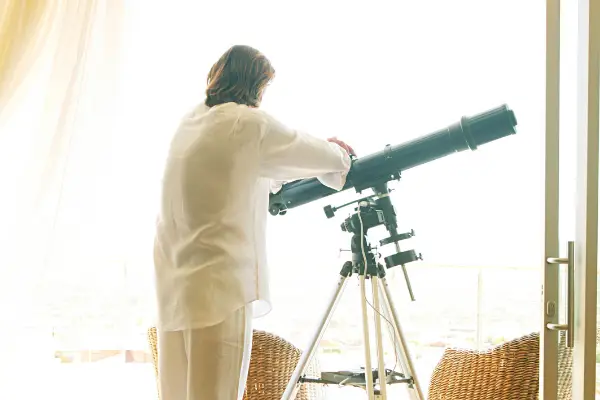
A terrestrial telescope is the best way to explore the land, ocean, wildlife, birds, architecture, or even people, as these telescopes are truly versatile as they are great for a beach house and also good for entry level astronomy. Here are a few features to consider in case you are in the market for a land viewing telescope.
Things To Look For In A Terrestrial Telescope
Aperture
Aperture is the diameter, usually measured in millimeters, of the objective (primary) lens or mirror of the telescope. Essentially, the larger the aperture, the brighter images will appear, and the further you will be able to see.
Magnification
Terrestrial telescopes are most commonly used for high magnification viewing over long distances in daylight. Image quality at different magnifications will depend on the optical system, the quality of glass used and the coatings applied to the surfaces of each lens.
Correct Image Diagonal
A terrestrial telescope needs to have a correct-image diagonal. In some cases, a regular telescope will be compatible with the provisions for the correct-image diagonal, but you may have to buy the actual corrector separately. In other cases, the correct-image diagonal will be inbuilt and you can use the device to view terrestrial objects during the day and celestial objects during the night. With a correct-image diagonal, you will be looking at the object as it is and there will be no distortions or inversions. This is the fundamental requirement of a terrestrial telescope.
Durability
The land viewing telescopes should be durable and should also be able to tolerate a bit of shock as they need to be taken into the field by hunters, birders, and wildlife watchers.
Portability
The terrestrial telescopes should be small, lightweight and portable as they need to be carried and used in the field. It’s even better if these scopes come with their own carrying case or a backpack that will not only allow for easy transportation but will also protect the telescope’s body from wear and scratches or any major damage.
Advantages & Uses Of A Terrestrial Telescope
A terrestrial telescope has many advantages and uses.
- You can quickly change the magnification power to provide zooming in and zooming out
- Doesn’t require the purchase or use of any additional equipment/lenses (i.e., image erector diagonal). As you either don’t need one or an image corrector diagonal comes along with the package.
- Excellent daytime image quality results
- Compact size and lightweight which is good for portability.
- May be used for entry-level astronomy activities, such as view larger/brighter object (e.g., moon, some planets)
- Terrestrial telescopes also have good close focus capability.
You can use the terrestrial or land viewing telescopes for various activities such as;
- Hunting
- Bird watching
- Wildlife viewing
- Ocean Viewing
- Surveillance
- People watching
- Observing the scenery
- Photography, If you couple a camera or a smart-phone with a terrestrial telescope you can turn it into a powerful telescopic lens.
Conclusion
A land viewing telescope is also great for studying the moon, seeing the four Jovian moons orbit Jupiter, and for seeing the rings of Saturn. Moreover, a terrestrial telescope makes it a great choice to have around the house or in the field because the entire family can get shared enjoyment out of it without too much hassle or fuss. Later on you can always add a more powerful telescope to the family and still have a spotting scope for daily use with birds and other wildlife.
Written by:

Chandrashekhara Rao
I grew up in a rural community with a dark sky, and that is where I learned to appreciate planets and stars at an early age. I have been fascinated with all things astronomical since I was a kid and started with a cheap-and-cheerful 60mm refractor on a wobbly tripod.
ABOUT US
We are a team of active amateur astronomers, here to help you with all your astronomy and science related needs – this is anything, from reviewing the latest telescopes to be released to talking about gravity and neurons. The Big Bang Optics was started because of our love for astronomy and to help others like us find the best telescope and accessories.
LEGAL DISCLAIMER
The Big Bang Optics is a participant in the Amazon Services LLC Associates Program, an affiliate advertising program designed to provide a means for sites to earn advertising fees by advertising and linking to Amazon.com. The Big Bang Optics also participates in affiliate programs with Clickbank and other sites. The Big Bang Optics is compensated for referring traffic and business to these companies.


